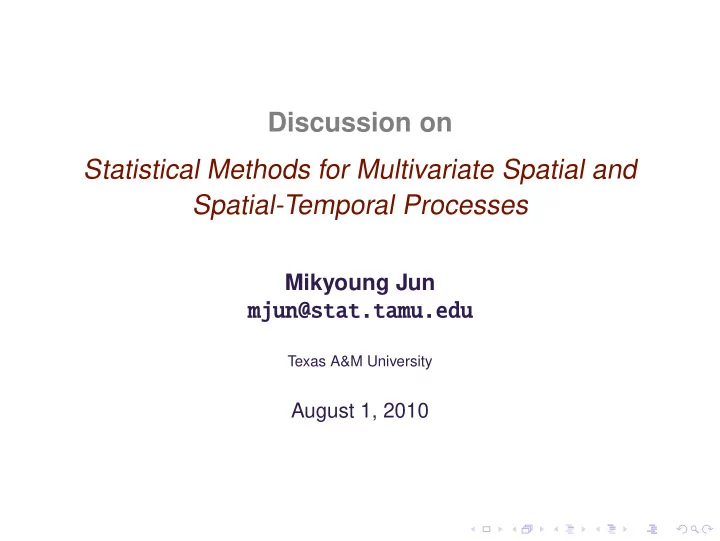

Discussion on Statistical Methods for Multivariate Spatial and Spatial-Temporal Processes Mikyoung Jun mjun@stat.tamu.edu Texas A&M University August 1, 2010
Linear Model of Coregionalization (LMC) � Goulard and Voltz (1992), Wackernagel (2003), Gelfand et al (2004), ... � Easy to build the covariance model for any number of processes, do not need to worry about positive definiteness � Extension for nonstationary processes: � Suppose we model temperature and precipitation jointly. T ( s ) = { a 1 · A ( s ) + b 1 · L ( s ) } Z 1 ( s ) + { a 2 · A ( s ) + b 2 · L ( s ) } Z 2 ( s ) , T , temperature, A , altitude, and L , latitude � Interpretation of the coefficients a i and b i ’s are tricky � We could let the coefficients of the independent processes be random but the implementation could be complex and there may be problems with identifiability or overparametrization
Mat´ ern cross-covariance function � Easy to implement, especially parsimonious version � Each covariance parameter is assigned to each marginal process or cross-covariance for a pair of processes: easy to interpret the parameters � In my limited experience, this model fits better (gives higher loglikelihood values) compared to the isotropic version of the LMC models with comparable number of covariance parameters
Mat´ ern cross-covariance function � Extension to nonstationary version? � Suppose Z 1 and Z 2 are bivariate processes with proposed Mat´ ern cross-covariance structure � If we let W i ( x ) = a i ( x ) Z i ( x ) , resulting covariance structure for W 1 and W 2 can be nonstationary. But the cross-correlation structure is still isotropic � How can we achieve nonstationary (cross-) correlation structure? � Currently cross correlation function is a constant multiplied by a Mat´ ern function, and thus monotonic function of distance � Could we let the co-located correlation coefficient parameter vary over space and achieve similar model classes?
Cross-covariance model via latent dimensions � Convenient to create rich classes of cross-covariance models � Same idea can be applied to univariate nonstationary covariance model to achieve nonstationarity in space (and time) � In that case, what should we do with the dimension for cross-covariance component?
Non-parametric cross covariograms � No need to estimate covariance parameters, assume certain parametric structure � Computationally fast and efficient � About finding the pairs of Z values that are perfectly correlated: � How sensitive is the result to this estimation? � How can we improve the poor estimation around the origin when the number of eigenterms is small?
Processes on a sphere? � Nonstationarity with respect to latitude is essential, asymmetry, nonseparability, and other complex structures may be more serious � Jun (2009): � Nonstationary covariance model for multivariate process on a sphere: m a ik ( L ) ∂ ∂ L + b ik ( L ) ∂ Z i ( L , l ) = � Z 0 k ( L , l ) � � ∂ l k = 1 � Differential operators are defined in L 2 sense � With small number of covariance parameters, we get the covariance dependence on latitude
Other issues with cross-covariance models � How much does it matter to have cross-covariance structure (rather than assuming independence) in prediction? � Suppose marginal covariance has some nice properties such as stationarity or isotropy � Does this require that the cross covariance structure should have the same nice property?
Recommend
More recommend